10.10.2016
With osteochondrosis, muscle spasm inevitably occurs - a kind of protective reaction of our body. With impaired functioning of the vertebrae and reduced thickness of the cartilage, the muscles of the neck and back try to take on the entire load. As a result, they overstrain, a spasm occurs, designed to block the spine and prevent further damage to it. In this situation, a person is interested in how to relieve spasm of the neck muscles with osteochondrosis, because it causes pain, swelling, burning and other painful sensations.
Consider best practices and techniques for getting rid of muscle spasm in case of damage to the spine in the article.
With severe spasm traditional healers it is advised to apply ice in a bag to the back of the neck, and after a few minutes change it to a bottle with warm water. After contrast compress you need to gently stretch your shoulders and neck.
To prevent muscle spasm, it is important to sleep on, take vitamin complexes to strengthen the muscles of the neck with osteochondrosis, follow a diet with a decrease in salt and an increase in the volume of plant foods.
Also, you can not supercool and ignore the doctor's prescriptions regarding conservative treatment pathology.
Pain in osteochondrosis, spasms in the neck and shoulder girdle appear due to the rapid rhythm of life, huge physical exertion, stress or lack of movement.
There are many reasons leading to tension, a spasm of the cervical muscles occurs:
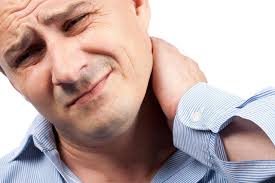
With cervical osteochondrosis, aching may also appear. pain in the arm, chest and neck. In certain positions or after hard physical work, the neck hurts and becomes numb. In some cases, dizziness, nausea, numbness of the fingers, ringing in the ears may occur.
The method of treatment will directly depend on the causes of the onset of the disease. For violations caused wrong position body at work and not enough dynamic lifestyle, the treatment will be easier. It is enough to conduct a course of manual therapy, enter physiotherapy exercises, eliminate excessive physical activity and properly organize the regimen. Sometimes massage is prescribed for such problems, but the choice of a specialist must be approached carefully. This rule applies not only to the massage therapist, but also to the chiropractor.
The cervical region has a complex structure, and improperly performed procedures can only harm, not eliminate pain.
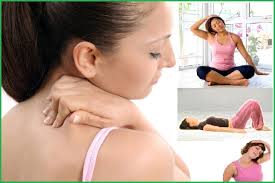 If infections are the cause, then medication is added to all of the above. About inflammation, the infectious nature of the disease can talk additional symptoms: sore throat during swallowing, nausea, pain in the chest.
If infections are the cause, then medication is added to all of the above. About inflammation, the infectious nature of the disease can talk additional symptoms: sore throat during swallowing, nausea, pain in the chest.
At the first signs that cause suspicion of cervical osteochondrosis, you need to contact a qualified specialist.
To prevent the occurrence of problems with the spine, you need to monitor your health. There are a number simple rules, which, with the correct organization of their regime, everyone will be able to perform:
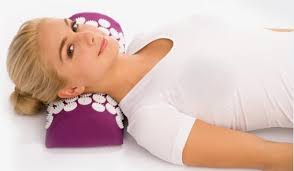
Exercises for cervical osteochondrosis
Daily Execution simple exercises will help prevent cervical osteochondrosis. All movements must be performed smoothly, monitor the evenness of breathing:
- Perform rotational movements with arms bent at the elbows. The fingers should be placed on the shoulders.
- Close your fingers behind your head and slowly take your hands back, bending slightly in your back and at the same time inhaling. Then, leaning forward and relaxing your arms, exhale.
- Perform smooth turns of the head, if pain occurs, stop the exercise.
Osteochondrosis is one of the diseases that develops rather slowly. At the first discomfort that occurs in the back and neck, you need to start giving more attention own health. Avoiding the appearance of osteochondrosis is quite simple, you just need to develop a few good habits.
Pain and restriction of freedom of movement are the main symptoms of any disease of the musculoskeletal system. These signs can indicate a variety of conditions - inflammation of the joints, muscle ruptures, fractures and cracks, as well as muscle spasm.
Any group of muscles of the body can spasm, for example, cervical motor fibers. Relaxation of the muscles of the neck and shoulders in this case can reduce pain, increase the patient's activity and improve his quality of life. How to relax the muscles of the neck?
Causes of spasms
To figure out how to relax the muscles of the neck, it is recommended to find out why spasms occur.
The causes of muscle tension can be:
- Osteochondrosis - leads to the appearance of a reflex radicular syndrome. This is the most common cause spasm.
- Sciatica - inflammation of the nerve roots due to their compression by a herniated disc.
- Spondylarthrosis is a degenerative-inflammatory disease of the joints of the spine. Leads to reflex inflammation and spasm of the neck muscles.
- Injuries of the spine and soft tissues of the neck. Even slight stretching after exercise can cause spasm.
- Infectious diseases, including damage to the meninges of the brain. In this case, the spasm is reflex in nature. Muscle relaxation occurs after the treatment of the underlying disease.
Diagnosing the cause of an illness is just as important as relieving symptoms. In some cases, the manifestations of the disease disappear only after targeted treatment.
Relaxation Techniques
Muscle relaxation is the result of complex symptomatic treatment. During therapy, the doctor can use a variety of techniques:
- Relaxing massage and impact on reflex points.
- Various ways physical impact.
- The use of medications.
- Exercises to relax the muscles of the neck.
To date, developed and successfully applied various methods exercise aimed at normalizing muscle tone neck and shoulders. The most popular methods of Mordovina and Kostyuk.
Any pathological syndrome and disease is easier to prevent than to treat. We will try to understand the issue of preventing spasms.
Massage

cervical spine and shoulder girdle most often exposed to a disease such as osteochondrosis. Exactly inflammatory process in the region of the tissues of the spine causes a reflex muscle spasm. Sometimes the pain and stiffness radiate to the back of the head.
Relaxation of spasmodic muscles is very important. One of the methods to achieve it is massotherapy. This method of treatment also has additional goals:
- Eliminates pain in the back and neck.
- Improves blood circulation in the affected area.
- Removes compression from the nerve roots.
- Increases the intensity of metabolism.
- Improves general well-being and performance.
- Fills the muscles with blood, prepares them for work.
All of these goals are achieved only if the massage is performed correctly. It can do qualified specialist preferably in a salon environment.
Self-massage of the neck and shoulders can be used to relax, but it will not be effective enough.
Another way to relax is the impact of acupuncture needles on the reflex points of the neck and shoulders. This method came to us from oriental medicine and shows a very good results. Acupuncture should only be practiced by a qualified professional with high level professional knowledge and practical skills.
Physiotherapy
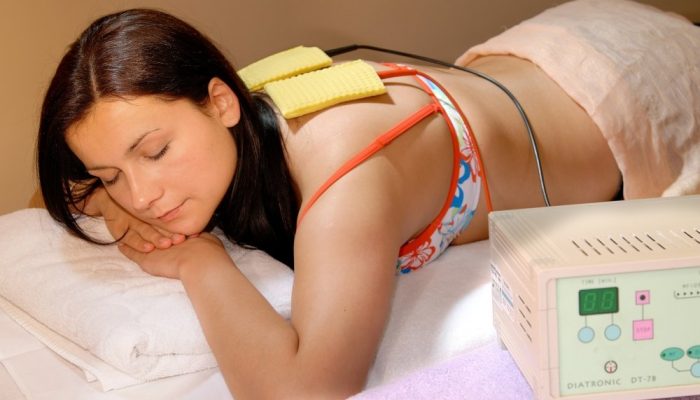
Physiotherapy methods also help to relieve the symptoms of osteochondrosis, get rid of muscle spasms and improve the condition of the soft tissues of the neck and shoulders. For this apply:
- UHF therapy.
- Electrophoresis and phonophoresis.
- galvanic currents.
- Heating with a laser.
- Electromyostimulation.
- Magnetotherapy.
Physiotherapy directly improves the condition of the back muscles, and also affects the nerve tissues and blood vessels. It helps to get rid of the symptoms of a variety of diseases.
Chronic muscle tension helps to remove the methods of mud therapy, therapeutic baths. These and other methods of physical influence are available in various sanatoriums. It is in hospitals that it is recommended to treat chronic diseases of the neck and back. There, qualified personnel correctly assesses the patient's condition and prescribes the necessary range of procedures.
Physiotherapy can also be obtained in the city. Many hospitals have physiotherapy rooms, where, if the patient has no contraindications, the neck muscles are treated.
Medicines

Relieve muscle spasm with medicines. For this, a group of muscle relaxants is used. The drugs are recommended for use in severe pain at the time of exacerbation, chronic use of muscle relaxants is unacceptable.
The most popular remedies from this group are Mydocalm and Sirdalud. They act on the mechanism of transmission of a nerve impulse from nerve cells to the muscle. The blockage of this process leads to the relaxation of muscle fibers and a decrease in pain.
Additional actions of muscle relaxants are inhibition of nerve conduction, an obstacle to the release of mediators and a decrease in the flow of calcium ions into synapses. As a result, peripheral blood flow improves, and nerve conduction slows down.
Muscle relaxants have a number of side effects:
- Weakness in the muscles of the whole body.
- There may be headaches.
- Decreased blood pressure.
- Nausea and vomiting, as well as a feeling of discomfort in various parts of the abdomen.
- Allergic reactions are extremely rare.
It is impossible to use drugs with hypersensitivity to their components, under the age of three years and with myasthenia gravis.
Doctors prescribe pills or injections 1-2 times a day. The dosage is set individually.
Exercises
To eliminate muscle spasm, it is rational to perform various sets of therapeutic exercises. Regardless of the chosen technique, all patients must comply with several conditions for such treatment.
Basic principles of exercise therapy:
- Start with small loads and gradually increase their volume.
- Before doing classes, it is recommended to consult a specialist.
- You should not perform high-amplitude exercises during the first workouts.
- Gymnastics is repeated at least 2 times a day - in the morning and in the evening.
- Wearing orthoses and collars also leads to relaxation. They are worn between classes.
- The combination of massage and exercise is very beneficial. Manual exposure is performed after exercise therapy.
Physiotherapy exercises are absolutely indicated for any neurological and orthopedic pathology. Loads for the muscles of the neck can only be harmful in acute infectious disease, so this cause of spasm must be excluded first.
Each pathological process requires different methods of exercise. You can choose an individual course of study for each person. They do it special doctors- Physical therapy specialists.
If visiting a doctor is a difficult event for you, use one of the ready-made methods for relaxing the neck muscles - the Mordovina or Kostyuk method.
Method Mordovina
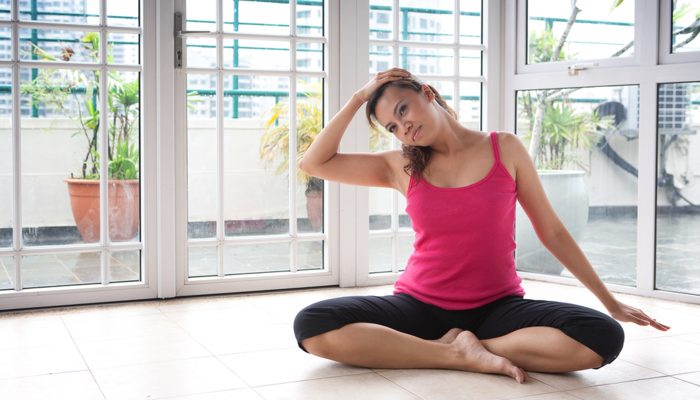
Alena Mordovina in her complexes combines fitness and therapeutic exercises to achieve the best cosmetic and health effect. She also recommends using the technique of relaxing the muscles of the neck in case of stress and regular static loads on this part of the spine.
The technique includes the following exercises:
- Raise and lower the shoulders - performed in a standing position. Feet together, shoulders at the same level. The head drops forward, and a series is performed with the shoulders quick exercise- up and down.
- Circular hand movements. The position of the body is the same. The brushes are clenched into a fist. At the moment of inhalation, the legs are bent, as if you are sitting on a chair, the arms are stretched forward. At the moment of holding the breath, the hands are performed circular motions, legs are straightened. We exhale quickly, and quickly press our hands to our sides and throw our fists forward.
- Head turns. Performed from a sitting position. The hands are folded into a lock and fixed in the region of the occipital fossa. The chin should be pulled up to the sternum, gradually press the back of the head on the hands. The head turns left and right at least 20 times.
- In the sitting position, the hands fold the lock and are placed in front of you. We lower the forehead in the palm of our hand, completely relaxing the muscles of the cervical spine. We turn from side to side, describing the eight with our hands.
- Stretching the back of the neck. In a sitting position, we put our hands in the lock on the back of the head. We press the back of the head on the lock and hold the neck like this for 6 seconds, repeat up to 8 times. This exercise should be done for the front and side of the neck.
Mordovina's method is completed with several cycles of calm breathing.
Kostyuk method
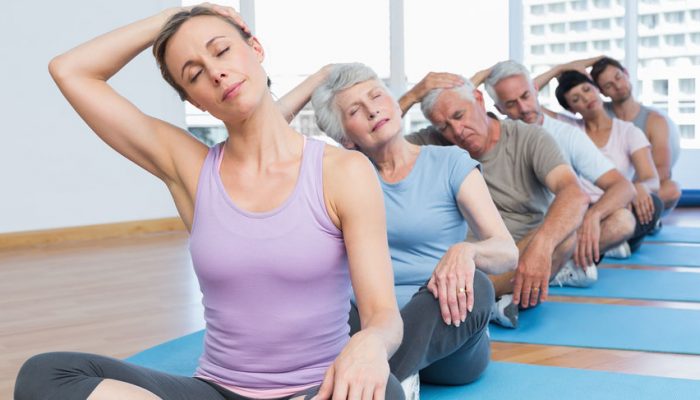
Dr. I.E. Kostyuk uses isometric relaxation methods to relax. The method can be performed at home or even at work.
Basic exercises:
- Sitting position, with a straight back. One hand is fixed on the neck, the other is fixed on the head and pulls the head in its direction. Tighten your neck muscles for up to 10 seconds, then relax. The exercise is repeated up to 3 times.
- To relax the back muscle group, we tilt our head forward and reach the sternum with our chin. We help with our hands by pressing them on the back of the head. We pull for 10 seconds. We relax. We repeat 3 times.
- Anterior neck. We tilt our head back and try to reach the neck with the back of the head. We fix the head with fists. We pull our head forward, but we resist with our hands. Gradually tilt your head more and more forward and pull the muscles.
- Deep muscles of the neck. We stretch the head forward, and pull the chin to one of armpits. With our hands we support the head from movement, but we try to tilt the head back. Muscles alternately tense and relax. We repeat up to 3 times. Repeat on the other side.
- We put one hand on the opposite shoulder. We pull the chin to the shoulder of the bent arm. We press the chin on the shoulder and resist the movement of the hand. We repeat the exercise at least three times.
Prevention
If you have osteochondrosis or your work is associated with a long immobile position of the neck, it is necessary to prevent the appearance of muscle spasms. Several times a day, it is worth repeating turns and tilts of the head or doing them as part of morning exercises.
Do not supercool the neck and allow exposure to stress factors. Physical exercise on the back, it is recommended to limit it somewhat, this will exclude the possibility of injury.
Additional advice can be obtained from your doctor. The specialist will also help relieve spasm, if it has already occurred.
When the back of the head and neck hurts, the causes can be associated with prolonged tension of the neck muscles, for example, when working on a computer or during any other work, accompanied by a forced position of the head and neck, as well as with cervical osteochondrosis. Such a spasm is reflex protective in nature.
Why does a spasm of the cervical muscles develop
Prolonged persistent spasm (hypertonicity) of the neck muscles is called the cervical muscular-tonic syndrome. At the same time, painful seals form in the muscles of the neck - the so-called trigger or starting points. At the same time, spasmodic muscles are shortened, compacted, which is reflected in the volume of their movements. If you press on the trigger points, there are signs of a muscular-tonic syndrome in the form of pain in the neck, radiating to the back of the head and arm on the affected side.
When the neck hurts  and neck, the causes may be different, but the most common is cervical osteochondrosis
and neck, the causes may be different, but the most common is cervical osteochondrosis  . Pain begins with irritation of the pain receptors of the intervertebral disc, and then intensifies due to a protective spasm of the neck muscles. Spasm of the neck muscles can also occur when the head and neck are in a forced position for a long time. This is a professional spasm, it develops, for example, in seamstresses, jewelers, office workers, and so on.
. Pain begins with irritation of the pain receptors of the intervertebral disc, and then intensifies due to a protective spasm of the neck muscles. Spasm of the neck muscles can also occur when the head and neck are in a forced position for a long time. This is a professional spasm, it develops, for example, in seamstresses, jewelers, office workers, and so on.
A spasm of the cervical muscles occurs because the defense reflexes of the affected area of the spine are turned on. For example, a spasm of the neck muscles occurs in response to irritation of the nerve roots in cervical osteochondrosis. In this case, a characteristic stiffness appears when the neck is fixed in a state of deformation, limiting the mobility of the spine in the affected area.
With prolonged muscle spasm in the affected area, blood circulation is disturbed, metabolic-dystrophic changes gradually appear, which lead to a decrease in the volume of muscle tissue.
Spasmodic neck muscles increase pain, pain sometimes becomes unbearable.
In addition, prolonged spasm of the cervical muscles leads to a curvature of the spine and increases the pinching of the nerves and blood vessels. Formed vicious circle: the more the nerve is irritated, the stronger the muscle tension, which means stronger irritation nerve and pain. This leads to the fact that patients try to limit their movements in order to reduce pain. If the back of the head hurts  , the causes must be established - only in this case, adequate treatment can be prescribed.
, the causes must be established - only in this case, adequate treatment can be prescribed.
What are the signs of a spasm of the neck muscles
The main symptom of neck muscle spasm is pain of varying intensity that occurs at trigger points and spreads to the back of the head and often to the entire head and arm, but does not reach the hand - this muscle pain differs from pain along the nerves. Pain in the neck is aggravated by prolonged forced stay in the same position, a sharp turn of the head, physical exertion, after hypothermia. The pain becomes less after rest, massage of the collar zone, therapeutic gymnastics, warming procedures.
If spasmodic muscles compress nearby nerves and blood vessels, sensitivity in the neck, neck, and arms may be impaired. Coldness and weakness in the hand on the affected side are also characteristic.
A spasm of the neck muscles can develop suddenly, due to a sharp turn of the head. Sometimes this is accompanied by a characteristic click, which indicates a displacement of the vertebra, trauma to the intervertebral disc and the formation of a hernia of the cervical spine. There is a very strong pain that forces the patient to take a forced position.
What can be done to help the patient
Since spasm of the neck muscles is often accompanied by severe pain, the first aid is to relieve these pains. For this purpose, appointed medications from the group of muscle relaxants of central action (for example, Mydocalm, Sirdalud). The mechanism of their action is associated with the interruption of the transmission of nerve impulses from spinal cord to the affected muscle. When the spasm of the muscle passes, its blood supply improves and the pain fades. Some muscle relaxants (for example, Sirdalud) also have an analgesic effect.
Neck muscle tension typical problem office workers. Pain in cervical region contributes not only to fatigue due to prolonged sedentary work. Spasms of the cervical muscles, stiffness and pain may indicate the development of osteochondrosis of the cervical spine.
To stop the development of pathology and prevent complications, perform therapeutic exercises. Take time to self-massage the neck muscles. Pay attention to preventive advice.
If a profession forces you to spend a lot of time in a chair at a computer, sooner or later a person will have to find out what stiffness in the neck muscles is. Its symptoms are constant muscle spasms and aching pain syndrome. At the end of the working day headache, “shoots” in the neck, dizziness, pre-fainting occurs. These symptoms provoke constant muscle tension. Further, osteochondrosis of the cervical spine develops. Complications may become more dangerous pathologies spine and circulation. To stop this process, you need to remove the load from the muscles, give the neck a rest.
- Also read:
Most likely, you are reading this article while sitting at your computer. Assess if your neck is in the correct position:
- Shoulders should not be raised;
- Trapeze should not be tense.
Trapezes are often overloaded for the following reasons:
- stress and fatigue;
- Raised shoulder position;
- Shoulders are pushed forward (stoop).
Consequences and treatment
The neck contains many nerves and capillaries that feed the brain and transmit its signals to the body. The vertebrae of the neck are the thinnest, there are only seven of them. In this case, the cervical vertebrae must withstand up to eight kilograms of the weight of a human head! To support the head, the body has supplied this area with 32 muscles that help keep the head level, help move and protect. cerebral circulation. The neck contains four large arteries and eight nerves, as well as the most important compartment of the spinal cord. Here is the blood supply center of the brain, internal organs chest, arms
Tension in the neck negatively affects the functioning of blood vessels and nerves. Less oxygen is supplied to the brain and nutrients muscles weaken.
As a result, a person suffers from. The head starts to hurt, it is harder to move the neck. If tension persists for many years, wrinkles and puffiness of the face appear faster. A migraine appears, vision deteriorates, salts accumulate. The nerve roots of the spinal cord are pinched, because of which the patient suffers from sciatica, getting more and more complications.
Exercises
There are a few simple ways how to relieve tension from the trapezium. They will help get rid of pain and stiffness:
- Straighten your back, pushing your chest forward (suitable if you constantly slouch);
- Raise and lower your shoulders to the maximum several times;
- Just completely relax the cervical region and shoulder girdle.
- Read also:
To relax your neck therapeutic exercises, you must first correctly position your head. At first, lift the back of the head a little, imagining that something is pulling from above by the crown. Move your chin back slightly, pulling it inward. These movements relax the neck and head region, help to say goodbye to the habit of holding the head too low or too high. Breathing is released, the back is straightened.
- Relax your shoulder girdle and stretch your crown to the top. Try to feel while slightly turning your head in different directions;
- Then put the picks on the chest and rub them with the clavicular region. Gently, without moving sharply, turn your head wider and wider;
- After that, throw your head back and try to rub the bottom of the neck with the occipital region;
- During seated work, watch the position of your shoulders and if they rise, lower them. So you relax your trapezium, save your neck from unnecessary spasms.
Osteochondrosis causes pain and a feeling of stiffness. There is another simple exercise that quickly relieves these symptoms. Place your hand on the opposite shoulder so that thumb touched the neck. Massage the large and index muscles that connect the neck with the shoulders. Repeat on opposite side
Self massage
Pain syndrome and spasms of the muscles of the collar region can be symptoms cervical osteochondrosis. To improve the condition of the intervertebral discs and relieve tension from the neck, conduct self-massage sessions at home. Perform all movements vigorously, but avoid discomfort. The strength of the impact is growing on the rise. Massage movements always run down the neck.
- Perhaps you need information: ?
- Stand or sit on a hard chair, straighten your back;
- Putting both palms on the neck, stroke it, touching the trapezium. Then squeeze with the edge of the palm first one side of the neck, then the other, already with the thumb;
- Rub the neck muscles, performing rotational movements in a circle from the middle to the sides. Do kneading the muscles by clasping them with your palms. End the session with strokes;
- Having finished self-massage of the back muscles of the neck, go to the front ones. First, stroke the entire front of the neck with one palm, clasping it with your fingers. An important note - try not to affect the thyroid gland, but when stroking, do not put pressure on it;
- Behind the ears, locate the mastoid muscles of the neck. Rub them with rotational movements of your fingers, moving from top to bottom;
- Then pinch these muscles in turn, after tilting your head to the side;
- Finish the procedure by stroking the front. You can interrupt them in the middle of the process and pat your muscles a little. After a session of self-massage, rest, relax.
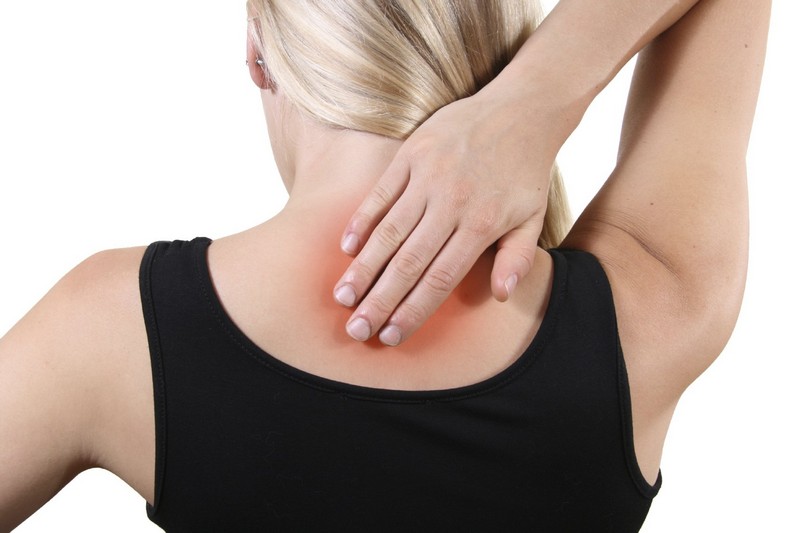
- Read also:.
Prevention
To prevent development pathological processes in the cervical region, pay attention to preventive recommendations:
- reset overweight. The spine and its muscular corset is not designed for a large body mass. As a result, the spine is compressed, and the intervertebral discs suffer dystrophic changes;
- Maintain good posture. In addition to the fact that a person looks presentable this way, he also relaxes the cartilaginous tissues of the discs;
- When working in the office, don't lean over the keyboard. Choose a chair and table where you don't have to keep your back crooked. Try to get up more often and rest, do a little warm-up;
- Even while at work, you can do a simple exercise to strengthen your neck muscles. Straighten your back, stretch the crown to the top. Place your hand on your head and apply some pressure. Look down and stay level despite the pressure. Focus on stretching the scalp and neck muscles. Do ten reps;
- When talking on the phone for a long time, do not press your ear to your shoulders;
- Your pillow should be neither too soft nor too hard. It should not be higher than ten centimeters and must have rectangular shape. Buy ideally.
| Your feedback on the article |














